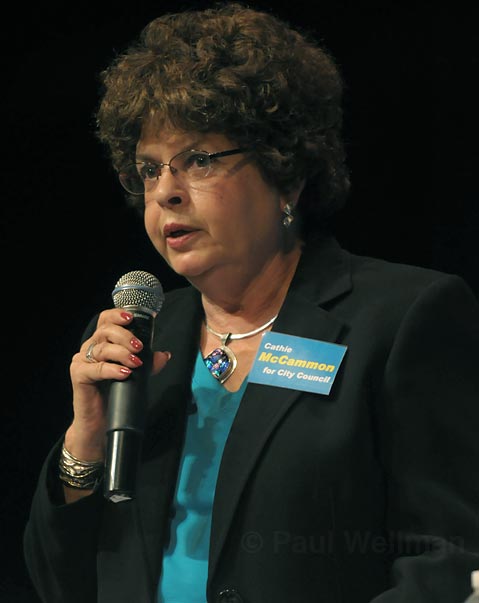Cathie McCammon
2009 City Council Candidate Profile
Unlike the two other council candidates backed by Van Wolfswinkel’s slate, Cathie McCammon has been a card-carrying and active Democrat all her life. For many years, she was intimately involved with the Democratic Central Committee, not to mention the League of Women Voters, Citizens Planning Association, and the Allied Neighborhood Association. An old-school slow-growther and ardent neighborhood preservationist, McCammon does not seem struck by the odd political company she now finds herself keeping. “I didn’t pick the PAC,” she said. “They picked me.”

She could just as well have said that she didn’t ditch the Democratic Party, the Democratic Party ditched her. In the embryonic stages of the race, the Democratic Party announced its endorsements without having invited McCammon to an interview. McCammon concedes she was slow to enter the race, but her name was clearly out there. Of Van Wolfswinkel, she said, “He’s a very kind, gentle, quiet man, very nice, not at all like he’s portrayed. And he’s passionate about preserving Santa Barbara.” Of the negative advertising blitz taking place, McCammon was quick to blame opponents of Measure B and the Democrats of giving as good – or as bad – as they got.
For the past 37 years, McCammon has sat through thousands of hours of City Council meetings, testifying frequently on various land use matters. Her critiques are painstakingly detailed and thorough, her delivery slow and deliberate. She will not be hurried, nor – according to both friend and foe – can she be easily swayed. She first ran for council 10 years ago and did not win. She’s trying again, she explained, because she regards Plan Santa Barbara – which sets the land use template for the next 20 years – a “hoax and a joke.”
She complained the process has been hijacked by architects, developers, and affordable housing advocates, all of whom she said have a financial stake in a higher density “new urbanist” future. “Architects have this vision, but it’s very different from the vision of a lot of other people,” she said. She took exception with the idea of reducing parking requirements on new development, for example, an idea proposed to reduce the cost of housing and to spur residents to avail themselves to mass transit. “If you don’t provide enough parking, it doesn’t meant that people will take the bus downtown; it means they won’t go downtown,” she said. “We aren’t getting the kind of solutions from Plan Santa Barbara that address Santa Barbara’s problems.”
An ardent proponent of Measure B, McCammon said it will protect the city’s skyline but it won’t inhibit the development of affordable housing. The only “affordable” housing produced by the large mixed use developments sprouting up along Chapala Street, she said, are hardly affordable to most people. To qualify to buy an affordable unit in one, she said, a couple must make at least $150,000. In others, families are expected to live in 950 square feet boxes that face an interior courtyard with no green space or place for kids to play. If the city wants to promote economic diversity by expanding home ownership opportunities, she said City Hall should encourage nonprofits to build more subsidized housing. “Nobody ever told me I could live in Hope Ranch or Montecito, so I never felt entitled to it,” she said.
On the budget, McCammon said city employees are paid too much. “Public employees are now making more than people in the private sector. But in the private sector people are getting laid off and having their wages cut back,” she said. “That’s not happening in the public sector.” To reduce gang violence, McCammon suggested that City hall spread the word that mentors are needed to help young kids before they’re enticed by gang membership. No special skills are needed, McCammon said, just an open heart.
McCammon takes a dim view of bulb-outs. Though designed to calm down traffic, she said, they induce anxiety instead. “I get nervous. I wonder what just happened to that bicyclist that was next to me,” she said. She said aggressive panhandling was a big problem and that she herself has felt intimidated. “We should stop the intimidation of our residents,” she said, “but I don’t think anyone has a handle on it.” Businesses need to shoulder their responsibility to get a “compassionate giving” program off the ground as an alternative to panhandling, she said, so that police can begin enforcing the new aggressive panhandling ordinance.
Ultimately, McCammon said City Hall has lost touch with average people. “If people think there’s a problem in their neighborhood, they need to be able to call up and talk about it,” she said. “They don’t need to get a lecture on what they should be thinking instead.”



